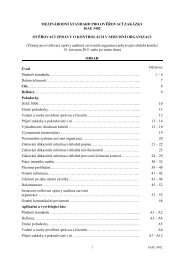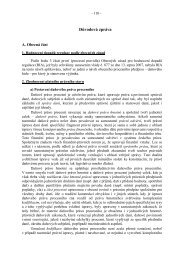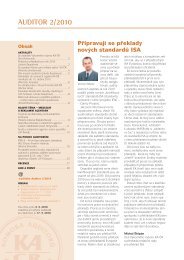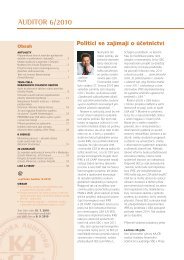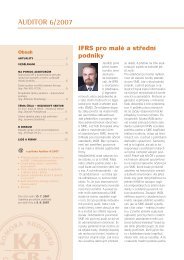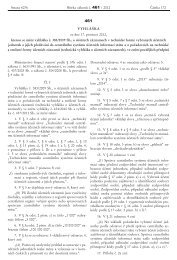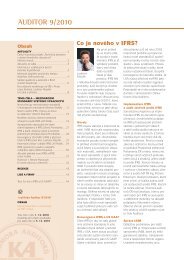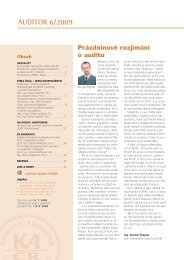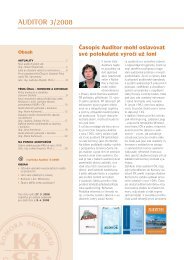Guide to Using International Standards on Auditing in - IFAC
Guide to Using International Standards on Auditing in - IFAC
Guide to Using International Standards on Auditing in - IFAC
You also want an ePaper? Increase the reach of your titles
YUMPU automatically turns print PDFs into web optimized ePapers that Google loves.
73<br />
<str<strong>on</strong>g>Guide</str<strong>on</strong>g> <str<strong>on</strong>g>to</str<strong>on</strong>g> <str<strong>on</strong>g>Us<strong>in</strong>g</str<strong>on</strong>g> <str<strong>on</strong>g>Internati<strong>on</strong>al</str<strong>on</strong>g> <str<strong>on</strong>g>Standards</str<strong>on</strong>g> <strong>on</strong> <strong>Audit<strong>in</strong>g</strong> <strong>in</strong> the Audits of Small- and Medium-Sized Entities Volume 1—Core C<strong>on</strong>cepts<br />
CONSIDER POINT<br />
When the entity has a mix of manual and au<str<strong>on</strong>g>to</str<strong>on</strong>g>mated c<strong>on</strong>trols, always identify who is resp<strong>on</strong>sible for<br />
the operati<strong>on</strong> of each c<strong>on</strong>trol. For example, suppose a warehouse manager is resp<strong>on</strong>sible for shipp<strong>in</strong>g<br />
goods. The warehouse manager manually <strong>in</strong>puts the data <strong>in</strong><str<strong>on</strong>g>to</str<strong>on</strong>g> a sales system that has an applicati<strong>on</strong><br />
c<strong>on</strong>trol <str<strong>on</strong>g>to</str<strong>on</strong>g> match the shipment <str<strong>on</strong>g>to</str<strong>on</strong>g> the orig<strong>in</strong>al order. If someth<strong>in</strong>g goes wr<strong>on</strong>g <strong>in</strong> the match<strong>in</strong>g process,<br />
is it the resp<strong>on</strong>sibility of the warehouse manager, the IT department, or the account<strong>in</strong>g department?<br />
Unless <strong>on</strong>e pers<strong>on</strong> is assigned resp<strong>on</strong>sibility for the entire process, people will <strong>in</strong>evitably blame each<br />
other when errors are made.<br />
Where resp<strong>on</strong>sibility has not been assigned, c<strong>on</strong>sider:<br />
• The likelihood and magnitude of potential misstatements that could occur <strong>in</strong> the f<strong>in</strong>ancial<br />
statements;<br />
• The appropriate audit resp<strong>on</strong>se; and<br />
• Whether the matter should be reported <str<strong>on</strong>g>to</str<strong>on</strong>g> management.<br />
5.11 Pervasive C<strong>on</strong>trols<br />
Paragraph #<br />
Relevant Extracts from ISAs<br />
315.14 (b) The audi<str<strong>on</strong>g>to</str<strong>on</strong>g>r shall…evaluate whether:<br />
(b) The strengths <strong>in</strong> the c<strong>on</strong>trol envir<strong>on</strong>ment elements collectively provide an appropriate<br />
foundati<strong>on</strong> for the other comp<strong>on</strong>ents of <strong>in</strong>ternal c<strong>on</strong>trol, and whether those other<br />
comp<strong>on</strong>ents are not underm<strong>in</strong>ed by deficiencies <strong>in</strong> the c<strong>on</strong>trol envir<strong>on</strong>ment. (Ref: Para.<br />
A69-A78)<br />
This chapter has now addressed each of the five comp<strong>on</strong>ents of <strong>in</strong>ternal c<strong>on</strong>trol. Some of these c<strong>on</strong>trols are<br />
pervasive <strong>in</strong> nature and <strong>on</strong>ly <strong>in</strong>directly serve <str<strong>on</strong>g>to</str<strong>on</strong>g> prevent a misstatement from occurr<strong>in</strong>g, or <str<strong>on</strong>g>to</str<strong>on</strong>g> detect and<br />
correct it after it has occurred. Other c<strong>on</strong>trols relate <str<strong>on</strong>g>to</str<strong>on</strong>g> particular transacti<strong>on</strong> risks (such as payroll, sales, and<br />
purchases) and are designed specifically <str<strong>on</strong>g>to</str<strong>on</strong>g> prevent or detect and correct misstatements.<br />
The follow<strong>in</strong>g exhibit shows the <strong>in</strong>teracti<strong>on</strong> of the two levels of c<strong>on</strong>trol over transacti<strong>on</strong>s as they journey from<br />
<strong>in</strong>itiati<strong>on</strong> and process<strong>in</strong>g (transacti<strong>on</strong>al level) through the account<strong>in</strong>g records (entity level) and f<strong>in</strong>ally <str<strong>on</strong>g>to</str<strong>on</strong>g> the<br />
f<strong>in</strong>ancial statements. Notice that at least three of the five <strong>in</strong>ternal c<strong>on</strong>trol comp<strong>on</strong>ents c<strong>on</strong>sist primarily of<br />
pervasive c<strong>on</strong>trols.




